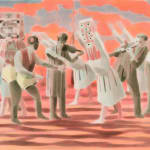Adam Dix British, b. 1967
The Dance, 2017
Ink and oil glaze on paper
49 x 70 cm
19 1/4 x 27 1/2 in
60 x 81 cm framed size
19 1/4 x 27 1/2 in
60 x 81 cm framed size
Copyright The Artist
Ensemble is a painting that loosely uses the subject of the Mummers Plays. These were European primitive folk performances / plays that were performed by a troupe of amateur actors,...
Ensemble is a painting that loosely uses the subject of the Mummers Plays.
These were European primitive folk performances / plays that were performed by a troupe of amateur actors, that would travel from village to village performing and relaying information that related to key calendar festivals or historical events.
Orally passed down and visually crude in costume, they would sometimes be accompanied by music. The origins date back to the Middle Ages and tell a mix of traditional stories with popular cultural references. A lot of traditional customs of that time were ‘story telling’, where superstitions and omens were commonplace, relating to fertility, life, death and a prosperous harvest; today some of these customs remain in conjunction with contemporary life, a residue that has a strange and disconnected surreal quality.
The characters in my troupe combine the past or the traditional with contemporary references to other social platforms. The performer to the left is the ‘Doctor’ who in traditional plays would revive the other performers, but here relates to my Shaman character of previous works. His face disguised by a black covering which represents the black gloss of a ‘Screen’ waiting to be engaged and the bells around his waist represent that of the sound of ‘Notifications’. He is the provider or conduit to the social platform, beckoning.
The central figure, again disguised has a hood of many eyes, to represent the idea of optical saturation or being transfixed by the screen whilst ‘Searching’.
The final performer (background left of colour study) is ‘Maiden’ who again was influenced by a dual interest in folk customs and contemporary means of communication. The cloak is a ceremonial garment, with the headdress based on theatre drapery, with symbols of contemporary communication signs, such as the 'wireless' symbol, a dish, a 'search' symbol and a human figure made from circuit symbols; along with a pixelated mask disguising the true identity of the performer to add to the anonymity and illusion.
‘Ensemble’ embodies the past and present in one, regarding elements of communication, theatre, religion and superstition; a performance representing continual communication and the growth in the worship of digital communication.
These were European primitive folk performances / plays that were performed by a troupe of amateur actors, that would travel from village to village performing and relaying information that related to key calendar festivals or historical events.
Orally passed down and visually crude in costume, they would sometimes be accompanied by music. The origins date back to the Middle Ages and tell a mix of traditional stories with popular cultural references. A lot of traditional customs of that time were ‘story telling’, where superstitions and omens were commonplace, relating to fertility, life, death and a prosperous harvest; today some of these customs remain in conjunction with contemporary life, a residue that has a strange and disconnected surreal quality.
The characters in my troupe combine the past or the traditional with contemporary references to other social platforms. The performer to the left is the ‘Doctor’ who in traditional plays would revive the other performers, but here relates to my Shaman character of previous works. His face disguised by a black covering which represents the black gloss of a ‘Screen’ waiting to be engaged and the bells around his waist represent that of the sound of ‘Notifications’. He is the provider or conduit to the social platform, beckoning.
The central figure, again disguised has a hood of many eyes, to represent the idea of optical saturation or being transfixed by the screen whilst ‘Searching’.
The final performer (background left of colour study) is ‘Maiden’ who again was influenced by a dual interest in folk customs and contemporary means of communication. The cloak is a ceremonial garment, with the headdress based on theatre drapery, with symbols of contemporary communication signs, such as the 'wireless' symbol, a dish, a 'search' symbol and a human figure made from circuit symbols; along with a pixelated mask disguising the true identity of the performer to add to the anonymity and illusion.
‘Ensemble’ embodies the past and present in one, regarding elements of communication, theatre, religion and superstition; a performance representing continual communication and the growth in the worship of digital communication.
Join our mailing list
* denotes required fields
We will process the personal data you have supplied in accordance with our privacy policy (available on request). You can unsubscribe or change your preferences at any time by clicking the link in our emails.



